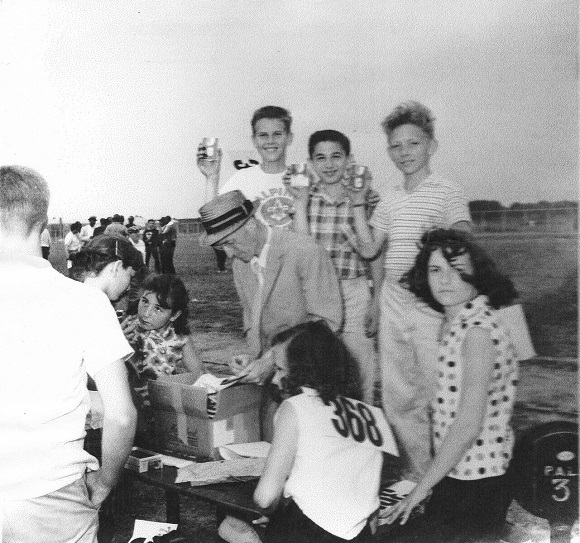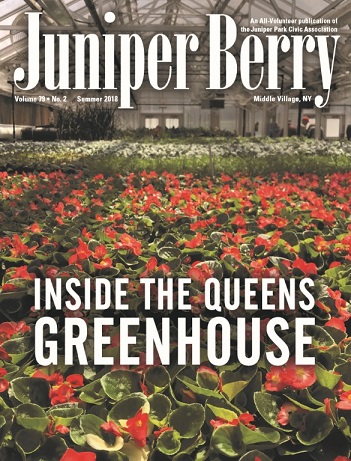The Fall 2017 issue of the Juniper Berry featured coverage of how Brennan Field was re-discovered by the Brennan family itself. Now, details have become available as to how the field and its adjacent areas were designed and built. This was an endeavor which began in the mid- to late 50’s and extended to 1968; and the story behind the story of Brennan Field is that of Queens homeowner Harry A. McArdle.
Previous articles on park history have related that the legendary N.Y. character Arnold Rothstein had buzzed by, acquired, and subsequently forfeited “Juniper Swamp” back to the City. Whatever Federal job-stimulation programs after the great depression of 1929 had presumably built up the tennis courts and all, left 20 acres at the Western end with trees in the perimeter, two access paths & some fencing, and the rest grassy stubble.
Enter on this scene “Helpful Harry”, Brooklyn-born ex middle distance runner, who had a full-time administrative job with the City, but whose heart was in his volunteer work with the Police Athletic League. Although his Rego Park home was in the confines of the 112th Precinct, in those days some Precinct boundaries were a bit different. The 112th station house was located within what would now be considered 104th territory and it was here he planned activities with the Patrolman assigned to P.A.L. duties.
He had begun recruiting at Resurrection-Ascension, the school his kids attended. In this large Catholic school – census about 1500 – official school-sponsored sports had yet to develop. There was outreach to other schools such as P.S. 41 and kids themselves spread the word in order to form good relay teams. The nearest track for practice was Victory Field at Woodhaven & Myrtle. Realizing the greater convenience of the Juniper area for many of the kids, McArdle had his “aha” moment: why not write to Robert Moses, bringing attention to the incompletely-developed parkland at Juniper which could accommodate a new track? After all, during Moses’ astounding 26-year tenure as Parks Commissioner, he was credited with creation of not less than 650 parks. He was, to mention just a fraction of his projects, builder of 13 bridges including the Verrazano Narrows & Triborough (now re-named for Robert F. Kennedy) and designer of a L.I. Parkway system of Northern & Southern State, Wantagh, & Meadowbrook including their interfaces with Jones Beach.
On Nov. 7, 1955, speaking as an interested citizen and as Athletic Chairman of his local Youth Council McArdle wrote to Moses and soon received a cooperative reply. The correspondence about the track part of the project is out of some lost world of efficiency. During 1956, the Planning Commission examined proposals from Parks & other competing departments, to result in its proposed (Citywide) 1957 Capital Budget Request (CBR). There, $10,000 of a larger sum requested for Juniper eventually made it through as approved.
Yet already 1956 marked the untimely death of Police Sgt. John P. Brennan, coach of the all-female Queens Mercurettes and former teammate of McArdle’s in the 7th Regiment (107th Infantry) in the Military Athletic League. (The 7th was founded in 1806 & its members were credited with being the first to leave N.Y. in defense of the national capital in April 1861 of the Civil War; hence tributes such as “The West Point of the National Guard”). More letters from McArdle drafted the wording of a commemorative plaque he adapted from the one on Randall’s Island honoring John Downing; and proposed naming the Juniper track-football field complex for Sgt. Brennan. This got the nod from Robert Moses who put him in touch with channels to go through as a formality. Funding, though, was seen as needing to be from non-CBR sources and the Patrolman’s Benevolent Association stepped up to the plate.
Ground was broken for the track. McArdle had visions of a championship-ready 400-meter track with a more state-of-art but costly synthetic material, perhaps ‘Permatrack’, as then preferred for elite tracks; but after some feelers, realized cinder-fill was what was in the cards. Trying to tweak the package for costlier material that would require a year or more to another CBR and was a gamble anyway, was just not feasible and a reminder why expressions like “Strike while the iron is hot” have come into our language: there was momentum because of the “Master Builder’s” presence.
The field with running lanes was completed, cinders & all, in time for a track meet and dedication on June 7, 1959 with the Brennan family in attendance; although the field did not open to the general public until late 1960 when the Contractor had responded to some compliance issues. In hindsight it was a good move, going with what Parks found to be the feasible materials; as into the 2nd term of Mayor Robert F. Wagner Jr. Moses was no longer available as Parks Commissioner. (This may have been simply his choice; or maybe there was a role for Mayoral annoyance as to dissent over a free admission policy for ‘Shakespeare in the Park’; added to relentless criticism from residents in opposition to Moses’ Lower Manhattan Expressway plan). At any rate by late ’59-early ’60 it was an accepted resignation as, keeping other titles, Moses assumed leadership for the ’64-’65 N.Y. World’s Fair, just as he had done for the ’39-’40 Fair.
After the early “Wow!” progress regarding the track, it became clear that a broader base of support was going to be necessary if the proposal was ever going to be realized in its entirety – that is, baseball diamonds, field house, & landscaping. The building of Shea Stadium in Queens was a major competitor for funds pre- & into 1960; and no less World’s Fair expenditures into the 60’s. As to Juniper, a 1958 amount had paid for track & playground. The 1961 budget had $37,400 for design & architect’s plans as regards the items above, but no provision for their actual construction. There had been a larger proposed sum, but it appeared headed for “defer until 1963” status.
Beginning May 1960, Newbold Morris had followed Moses as Parks Commissioner. At a budget hearing – these were open to the public & McArdle, concerned about Juniper, managed to be there. He noticed Morris had sent a subordinate to represent him, and that person left early without speaking up when wolves were nibbling at the Juniper plans. This did not escape notice and on the positive side became the impetus for a letter-writing campaign. Local leaders such as Martin J. Host Jr. (Ridgewood Lodge 1642, Loyal Order of Moose – it didn’t hurt that Borough President Clancy was a member); Leo Larney (Q. Mercurettes); Stan Yablonski (Kiwanis); and the press were among those enlisted. In those days there was a “Board of Estimate” including the 5 borough presidents with approval powers. The City Planning Commission was essential as it was the gateway for capital projects – recommending some to the Mayor & others as required by section 217 of the NYC Charter.
Powers-that-be got appeals from locals to “…combat juvenile delinquency. A healthy, athletic minded boy rarely becomes a problem to his community…” (The 50’s were just ending. There was still this much optimism. And at the time neither delinquency nor baseball were seen to have much to do with girls). Another letter bemoaned, “Are we being forced to reduce our youngsters to stick-ball in the streets?” This was the preliminary to a more structured case to be put on paper, which will be detailed in the next edition of the Juniper Berry.
*The author is the daughter of Harry McArdle



